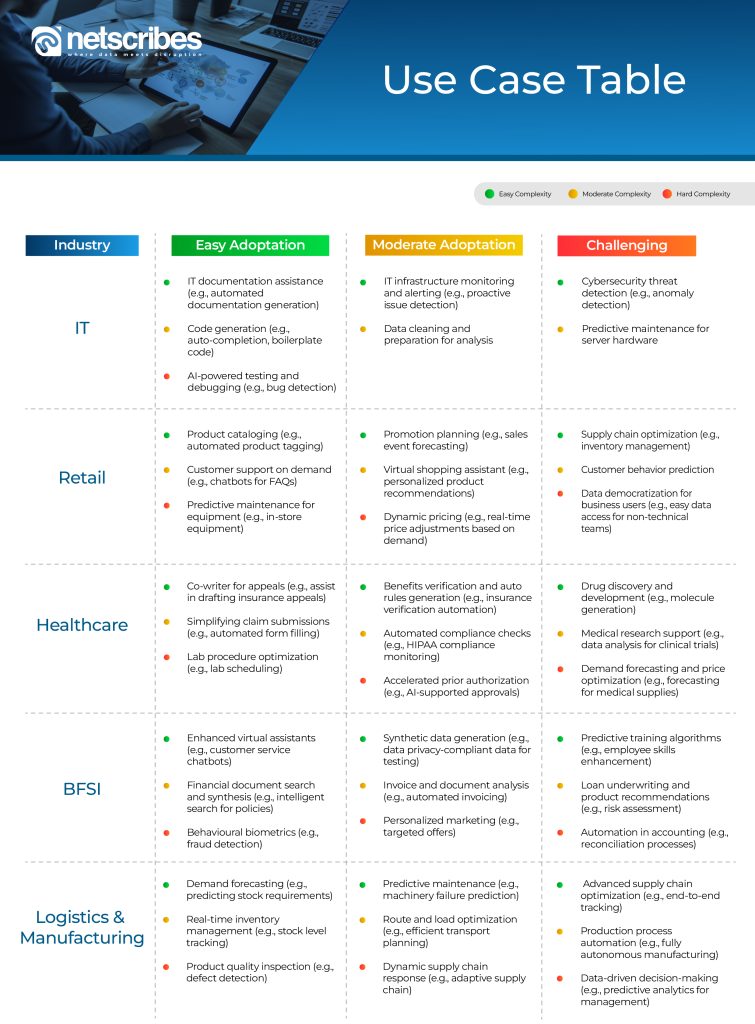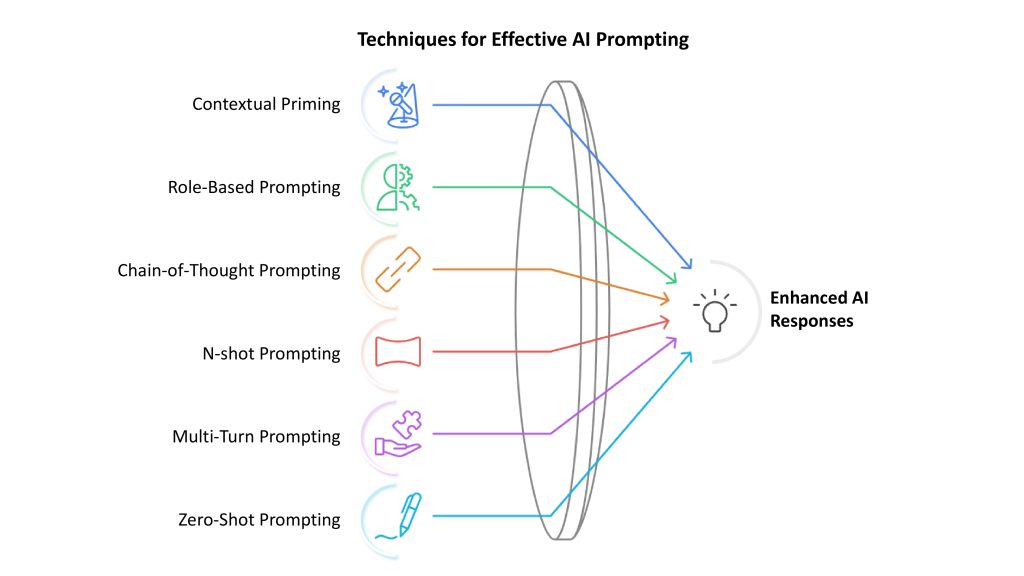Harnessing Generative AI for business advantage: from Vision to Value

As we navigate through 2024, the term Generative AI (GenAI) is everywhere, sparking conversations and capturing attention. It has evolved from a technological curiosity to a fundamental force reshaping business operations across industries. Generative AI for business is transforming how companies approach tasks, whether crafting stories, designing artwork, or coding. However, amidst the excitement and speculation, everyone is asking a crucial question: Is GenAI truly transformative or another technology bubble?
The truth about GenAI lies between the extremes of overblown hype and skepticism. While some early predictions about GenAI replacing entire workforces haven’t materialized, its impact on business efficiency and innovation is clear. According to recent findings:
● 65% of organizations already use GenAI in at least one business function. [McKinsey’s “State of AI in early 2024”]
● investment in GenAI reached $25.2 billion in 2023 [Stanford’s “AI Index Report 2024“]
● a majority of organizations have deployed less than a third of their GenAI experiments into production [Deloitte’s “State of AI in the Enterprise”]
While AI completely replacing work processes is far-fetched, there are positive signals that companies have started experimenting with and even deploying in certain use cases.
But what exactly is GenAI?
Generative AI isn’t a new phenomenon—it has been gradually evolving over the past few decades. The autocomplete features on our phones or personalized content recommendations we see are examples of AI operating at a more fundamental level. However, the critical difference now lies in the sheer scale and creativity that generative AI business applications can achieve. With significant advancements in neural networks and machine learning, today’s GenAI has become broader, smarter, and more powerful than ever before. The latest breakthroughs in language models, image generation, and multimodal AI have unlocked new realms of artificial creativity and problem-solving ability.
This is not just a passing trend; it’s reshaping how companies work, innovate, and compete. Regardless of the industry- be it whether BFSI, healthcare, or tech, the question isn’t whether to adopt AI but how fast one can adapt to its possibilities.
GenAI has gained traction across various areas, with the fastest adoption in sales and marketing, IT, and software development. As it continues to evolve, its applications are expanding beyond the initial expectations. Key areas that have seen high adoption are AI chatbots that facilitate human-like conversations and translation. This helps break down language barriers. Additionally, GenAI is making waves in content creation. It’s allowing businesses to craft personalized messages, write articles, and produce engaging social media content.
Is there a method to this madness?
Based on the degree of complexity and purpose of adoption, there are three strategic integration categories to consider: Implement, Compete, and Innovate. By integrating these categories, businesses can achieve end-to-end transformation.
Implement
This is the most obvious scenario. Implementing GenAI means incorporating it into the processes we already use. The key idea of integrating it into your daily workflow is to increase efficiency and thus boost overall productivity, allowing the current roles to become strategic and powerful. The first step is to look at the routine tasks, identify the ones that can be automated, and experiment with AI-driven solutions.
Consider a scenario where you’re responsible for sending a daily newsletter to internal stakeholders. Typically, this process involves manually searching for relevant articles, removing duplicates, writing a summary for each, and compiling it into an email. However, all these tasks can be automated—GenAI can analyze articles, identify unique ones, generate 2–3-line summaries, and assemble the newsletter. With GenAI handling the analysis and reporting, the production time is dramatically reduced.
Compete
The second scenario involves elevating current processes to unlock additional value previously unattainable. In today’s competitive landscape, leveraging GenAI is no longer just an option; it’s essential for staying ahead. Generative AI for business requires us to change how work gets done to achieve a higher return on investment (ROI). Competing effectively with GenAI requires completely overhauling your existing workflows and processes. This means to reimagine and reconstruct your entire workflow. Here is an example.
Imagine a company that operates a SaaS platform that assists organizations in managing third-party risk and contractor qualifications. Their service enables customers to conduct prequalification checks and access other related services. Traditionally, these checks are performed manually, presenting an opportunity to enhance the efficiency of the process.
Integrating advanced automated solutions and GenAI could significantly boost the process efficiency resulting in lesser manual bottlenecks and provides bandwidth to derive additional insights that makes it a higher value output which in turn creates a competitive edge in the market.
Innovate
Lastly, Innovate with Gen AI. To innovate with GenAI means more than just improving existing processes – it’s about creating something new. Generative AI for business provides the ability to build a product from scratch, powered by AI insights, offering a competitive edge that can position businesses as leaders in their field.
For example, a financial services company could leverage GenAI to design a revolutionary new investment platform that provides personalized portfolio recommendations and automated wealth management. Similarly, a healthcare provider could utilize GenAI to build a next-generation telehealth application that seamlessly integrates virtual consultations, customized treatment plans, and proactive health monitoring. By innovating with GenAI, businesses can go beyond simple automation to deliver unique, customer-centric solutions that set them apart, helping them to capture new market opportunities and establish a strong competitive advantage.
Adoption Trends of GenAI Through Industry Use Cases
Building on the strategic approaches of Implement, Compete, and Innovate, examining how these frameworks are brought to life within specific industries is essential. Generative AI is uniquely transforming sectors with tailored applications that address industry-specific needs and challenges. In the following section, we explore key use cases across fields.
Below is a table with use cases ordered by complexity within each cell. The industries are arranged from those with easier GenAI implementation potential to those where adoption is typically more challenging:

So how to make GenAI deliver results
Having established the foundational strategies for integrating GenAI, it is essential to understand and master one of the most critical skills – prompting. Why is this so important? GenAI, while powerful, still relies heavily on how we guide it. Effective prompting enables to extract specific and actionable insights from AI.
Take, for instance, as a market analyst, you are trying to identify the emerging trends in their industry. A basic prompt like “What are the latest trends?” might return a broad range of results. However, by refining the prompt to something like, “Identify the top three emerging consumer preferences in the health and wellness sector based on recent survey data and social media discussions,” the AI can deliver far more targeted, useful information. This level of precision is crucial for decision-making in today’s competitive business environment.

● Contextual Priming: This sets the stage for the AI’s response by providing background information before the primary prompt. For example, instead of asking, “What are the trends in digital marketing?” one might say, “Considering the rise of social media influencers, what are the current trends in digital marketing?”. This technique ensures the AI understands the specific angle for more targeted insights.
● Role-Based Prompting: This involves assigning a specific persona to the AI to guide the tone and direction of its response. For instance, asking, “As a seasoned project manager, what strategies would you recommend for improving team collaboration?” aligns the AI’s voice with the required context. This results in relevant and expert-level responses.
● Chain-of-Thought (CoT) Prompting: This encourages the AI to articulate its reasoning step-by-step. For example, prompting, “List the benefits of implementing AI in business and explain the reasoning behind each,” leads to clearer, more structured answers that facilitate deeper understanding.
● N-shot Prompting: This provides multiple examples to illustrate the expected output format. For example, presenting three effective customer testimonials before asking the AI to generate a new one helps it mimic the style and tone of the provided examples.
● Multi-Turn Prompting: This method breaks down complex queries into more straightforward, interrelated questions. Instead of asking, “How can we reduce costs while maintaining quality?”, one could inquire, “What are some common areas where costs can be reduced?”. This encourages thorough exploration of each aspect, yielding detailed insights.
● Zero-Shot Prompting: This entails asking the AI to perform a task without prior examples, such as requesting, “Summarize the key points from this article on AI ethics.”
Remember, prompting is an iterative process; achieving the ideal response on the first attempt is rare. Experiment, adjust your prompts, and gradually fine-tune your approach to achieve the best results.
Looking ahead
Gen AI is rapidly shifting from a promising technology to an integral driver of business transformation across industries. Generative AI for business is making its mark with its impact evident in increased productivity, operational efficiency, and innovative opportunity. Companies adopting Gen AI in stages—implementation, competition, and innovation—are positioning themselves not just to keep up, but to lead.
By 2025, industry leaders expect GenAI to drive transformative change, evolving from an assistive tool to a strategic collaborator. This shift in our work today will redefine skill sets, demanding a more adaptive and future-ready workforce to deliver high-value work. To fully leverage GenAI, companies are investing in skill development and training. This makes AI not just a technical asset but a central element of competitiveness. The synergy between GenAI and human expertise will shape a more productive future. In conclusion, bridging the gap from vision to value with Gen AI is critical—it’s time to take decisive steps to unlock its full potential.
Explore how your organization can harness this potential by checking out our AI Readiness Solutions.
This blog has been written by Ishika Rajesh Makwana, Data Analyst, Technology Solutions






